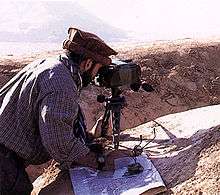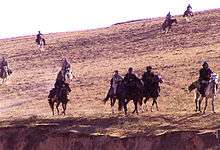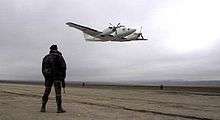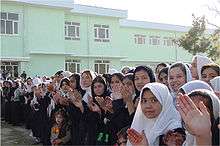Fall of Mazar-i-Sharif
| Fall of Mazar-i-Sharif | |||||||
|---|---|---|---|---|---|---|---|
| Part of the War in Afghanistan | |||||||
U.S. Army Special Forces soldiers with Northern Alliance fighters at Mazar-i-Sharif on 10 November 2001 | |||||||
| |||||||
| Belligerents | |||||||
|
|
| ||||||
| Commanders and leaders | |||||||
|
|
| ||||||
| Casualties and losses | |||||||
| 8 Junbish-i-Milli Islami[2] and 30 Jamiat-e Islami[3] fighters killed | 300+ killed,[4]~500 captured and ~1,000 defected[5][6] | ||||||
The fall of Mazar-i-Sharif (or Mazar-e-Sharif) in November 2001 resulted from the first major offensive of the Afghanistan War after American intervention. A push into the city of Mazar-i-Sharif in Balkh Province by the United Islamic Front for the Salvation of Afghanistan (Northern Alliance), combined with U.S. Army Special Forces aerial bombardment, resulted in the withdrawal of Taliban forces who had held the city since 1998. After the fall of outlying villages, and an intensive bombardment, the Taliban and al-Qaeda forces withdrew from the city. Several hundred pro-Taliban fighters, including many Pakistani volunteers, were killed. Approximately 500 were captured, and approximately 1,000 reportedly defected. The capture of Mazar-i-Sharif was the first major defeat for the Taliban.
Preparation
The Taliban recaptured the city in 1997 and controlled it thereafter.[7]
The decision to launch the war's first major strike against Mazar-i-Sharif came following a meeting between U.S. Army General Tommy Franks and Northern Alliance commander Mohammed Fahim in Tajikistan on October 30, 2001.[6]
In the days leading up to the battle, Northern Alliance troops advanced on population centers near the city, such as Shol Ghar, which is 25 kilometers from Mazar-i-Sharif. Phonelines into the city were severed,[8] and American officials began reporting accounts of anti-Taliban forces charging Afghan tanks on horseback.[9] On November 2, 2001, Green Berets from ODA 543 and small elements of the CIA SAD inserted into the Dari-a-Balkh Valley, after being delayed by weather for several nights, its role was to support General Mohammed Atta Nur and his militia. Together they fought through the Dari-e-Souf Valley and had linked up with General Abdul Rashid Dostum and his force and ODA 595 and the CIA team supporting Dostrum, who had also battled through the valley, outside Mazar-e-Shariff.[10]
General Dostum led the ethnic-Uzbek-dominated faction of the Northern Alliance, the Junbish-i-Milli Islami Afghanistan, in an attack on the village of Keshendeh southwest of the city on November 4, seizing it with his horse-mounted troops.[6] General Noor, meanwhile, led 2,000 men of the ethnic-Tajik-dominated Jamiat-e Islami forces against the village of Ag Kupruk directly south of the city, along with six Special Forces soldiers and seven others who directed bombing from behind Taliban lines north of the city. It was seized two days later.[6] Ethnic Hazara forces of Mohammad Mohaqiq's Hezbe Wahdat took part in the offensive.[3]
Propaganda leaflets were dropped from airplanes, showing a woman being struck by a man and asking if this was how the Afghans wanted to live, and listing the radio frequencies over which Americans would be broadcasting their own version of events.[11] Meanwhile, U.S. Special Forces set up laser designators to serve as beacons for guided munitions, highlighting targets around the city.[6]
On November 7, the New York University's Director of Studies on International Cooperation, Barnett Rubin, appeared before a hearing of the American House Committee on International Relations on "The Future of Afghanistan". He claimed that with Mazar-i-Sharif on the brink of invasion, the US was responsible to ensure that there were no reprisal killings of Taliban members by the Northern Alliance. He noted that when the city had been overrun (in 1997 and 1998), thousands had been murdered by both sides.[12]
Bombing campaign

On November 7 and 8, as the Taliban were moving 4,000 fighters across the countryside towards Mazar-i-Sharif in preparation for battle, American[1][11] B-52 bombers bombed Taliban defenders concentrated in the Chesmay-e-Safa gorge that marked the southern entrance to the city,[13] as well as the Haji Gak pass, which was the only Taliban-controlled entrance to the city.[14] This was one of the heaviest campaigns up to that point.[14] Nevertheless, the Taliban claimed they had infiltrated 500 fighters into the city to prepare for the coming battle.[11]
Battle

On November 9, 2001, members of the two ODAs and the CIA team positioned themselves in mountainside hides and began calling in airstrikes against the Taliban at Tangi Pass - the gateway from the Balkh Valley to the city where the US and Northern Alliance agreed to attack. The Taliban responded with indirect fire from BM-21 Grad rockets, which were quickly suppressed by orbiting air support, the airstrikes took their toll on the Taliban and at a signal Atta and Dostum Northern Alliance forces, began their assault by foot, horseback, pick up trucks and by some captured BMP armored personnel carriers.[16]
Initial rumors claimed that the Afghan fighters were unimpressed by the American bombardment and believed that their opponents refused to advance on the city.[8] At 2 p.m. Northern Alliance forces, under the command of Dostum and Ustad Atta Mohammed Noor, swept across the Pul-i-Imam Bukhri bridge[8] and seized the city's main military base and the Mazar-e Sharif International Airport.[13][14] The "ragtag" non-uniformed Northern Alliance forces entered the city from the Balk Valley on "begged, borrowed and confiscated transportation",[17] and met only light resistance.[18][19]
After outlying villages fell to precision air strikes on key command and control centers, approximately 5,000-12,000 Taliban combatants as well as members of al-Qaeda[20] and other foreign fighters began to withdraw towards Kunduz to regroup, travelling in pickup trucks, SUVs and flatbed trucks fitted with ZU-23-2's (anti-aircraft guns modified for ground combat).[5][21][22] By sunset, the Taliban forces had retreated to the north and east.[13] Some feared that they were massing for a counter-offensive.[23] It was later estimated that 400-600 people died in the battle, although it was not possible to separate civilian and combatant deaths.[24] Approximately 1,500 Taliban were captured or defected.[5][6]
Pakistani volunteers
As many as 900 Pakistani volunteers reached Mazar-i-Sharif in the following days while the majority of the Taliban were evacuating. Many of these fighters were recruited by a Pakistani Mullah, Sufi Mohammed, who used a loudspeaker riveted onto a pickup truck which blared, "Those who die fighting for God don't die! Those who go on jihad live forever, in paradise!"[3][25][26]
When these volunteers reached the city in the days when the Taliban were evacuating, many of them were alone and confused. The group, chiefly consisting of teenage boys,[25] gathered in the Sultan Razia Girls' School, where they began negotiating their surrender, but hundreds of them were ultimately killed.[3][26] For almost two days as the group gathered in the abandoned Sultan Razia Girls' School and built up their fighting positions, the town officials and Northern Alliance attempted negotiations for their surrender, but the fighters vehemently refused, ultimately killing two peace envoys, one town mullah and a soldier escort. All the while they constantly fired at anyone who moved within the vicinity of the building, including civilian bystanders.
After the envoys' murder, the Northern Alliance began returning fire on the school with machine guns. This gun battle went on for hours. Inside the battered school, someone scrawled on the walls the words of their mullah, "Die for Pakistan", "Never surrender" and "Our philosophy has been surrender or die."[4][19][27][28][29]
At mid-afternoon, U.S. military advisers approved the building for a bombing run. Army Col. Rick Thomas of the U.S. Central Command said they had determined the school was an appropriate target.
Officials from the United Nations and other organisations claimed that a massacre by Northern Alliance troops had followed after the defenders surrendered in the school, moments before an American warplane dropped two, or four, 1000-pound bombs. The fighters scattered quickly to escape, and the Northern Alliance shot at them as they fled, resulting in an alleged 800 fatalities. Later reports suggested instead that the Northern Alliance had shelled the school, rather than an American warplane dropping bombs on it,[4][19][27][28][29] but following the battle, United States Air Force Sgt. Stephen E. Tomat was awarded the Silver Star for calling in the air strike on six vehicles and the school.[30][31][32][33][34][35]
Aftermath


The fall of the city proved to be a "major shock",[30] since the United States Central Command had originally believed that the city would remain in Taliban hands well into the following year[37] and that any battle would be "a very slow advance". Mazar-i-Sharif was strategically important. Its capture opened supply routes and provided an airstrip inside the country for American aircraft.[23] The battle was the Taliban's first major defeat and precipitated a rapid transfer of territory in northern Afghanistan.[8][38][39] Following rumors that Mullah Dadullah might be headed to recapture the city with as many as 8,000 Taliban fighters, a thousand U.S. Army Rangers were airlifted into the city, which provided the first solid foothold from which Kabul and Kandahar could be reached.[1][40]
US Army Civil Affairs Teams from the 96th Civil Affairs Battalion and Tactical Psychological Operations Teams from the 4th Psychological Operations Group assigned to both the Green Berets and Task Force Dagger were immediately deployed to Mazar-e-Sharif to assist in winning the hearts and minds of the inhabitants.[41]
The fall of the city generated reports of jubilant excitement among locals,[42] followed by reports of summary executions and the kidnapping of civilians by the Northern Alliance.[43] The Pakistani prisoners who were captured fleeing the school were held as "slaves" and often sexually abused by their Northern Alliance captors, who demanded a ransom from their families for their return.[25] The American-backed forces now controlling the city immediately began broadcasting from Radio Mazar-e-Sharif, the former Taliban Voice of Sharia channel, on 1584 kHz,[44] including an address from former President Burhanuddin Rabbani.[11] Foreign media outlets were denied access to American troops or to battle sites at this time.[45]
The airfield, the city's main prize for the Americans, had been badly damaged by their bombardment and had been boobytrapped with explosives planted by the Taliban in and around the property as they left.[18] This created a rift between the United Kingdom and the United States. The former charged that the aerial bombardment had been ill-advised, that the United States had failed to pay sufficient attention to humanitarian concerns and had refused to consult with its allies.[46] The destroyed runways were patched by Afghans. The first cargo plane landed ten days after the battle.[18] The airbase was not declared operational until December 11.[36] While prior military flights had had to be launched from Uzbekistan or aircraft carriers in the Arabian Sea, the Americans now could fly more frequent sorties against the Taliban frontlines, carrying heavier payloads that replace the fuel necessary for the longer flights.[22]
References
- 1 2 3 Khan, M. Ismail. DAWN, Mazar falls to Alliance: Taliban says they're regrouping, November 10, 2001
- ↑ Wolfowitz, Paul, Speech on November 14, 2001
- 1 2 3 4 Gall, Carlotta New York Times, A deadly siege at last won, November 19, 2001
- 1 2 3 Gall, Carlotta. New York Times, Conflicting tales paint blurry picture of siege, November 20, 2001
- 1 2 3 Topeka Capital Journal, Taliban: Key city has fallen, November 10, 2001
- 1 2 3 4 5 6 Chipman, Don. "Air power and the Battle for Mazar e Sharif", Spring 2003
- ↑ Opposition troops closing in on Mazari Sharif
- 1 2 3 4 The Guardian, Taliban fall in Mazar-e-Sharif, November 9, 2001
- ↑ Independent Online, US, Taliban both claim success in offensives, November 8, 2001
- ↑ Neville, Leigh, Special Forces in the War on Terror (General Military), Osprey Publishing, 2015 ISBN 978-1472807908, p.38,p.41
- 1 2 3 4 The Guardian, Taliban lose grip on Mazar i Sharif, November 7, 2001
- ↑ United States House of Representatives, The Future of Afghanistan, November 7, 2001
- 1 2 3 Rebels: Mazari Sharif is Ours - TIME
- 1 2 3 Independent Online, Taliban braces for battle over Mazar-e-Sharif, November 9, 2001
- ↑ Rumsfeld, Donald. "Annual Report to the President and the Congress", 2002. Chapter 3.
- ↑ Neville, Leigh, Special Forces in the War on Terror (General Military), Osprey Publishing, 2015 ISBN 978-1472807908, p.41
- ↑ Hess, Pamela UPI, "US forces on horseback fighting Taliban", November 16, 2001
- 1 2 3 Cahlink, George. Building a Presence, December 15, 2002
- 1 2 3 "Special Warfare journal", "The Liberation of Mazar e Sharif: 5th SF group conducts UW in Afghanistan", June 1, 2002
- ↑ Chronology | Campaign Against Terror | FRONTLINE | PBS
- ↑ Harding, Luke. The Guardian, Fear of Bloodbath as Alliance advances on Kunduz, November 23, 2001
- 1 2 Dolan, Chris J. "In War We Trust", 2005. p. 150
- 1 2 New York Times, The Battle for Mazar-e-Sharif, November 10, 2001
- ↑ Los Angeles Times, Mazar i Sharif yields 400 to 600 bodies, November 23, 2001
- 1 2 3 Seattle Times, Boy lured by Taliban, now held as slave, July 29, 2002
- 1 2 Washington Post, "Taliban's Allies Lost in Strange City", November 11, 2001
- 1 2 The Telegraph, 600 bodies found in Mazar-e-Sharif, November 22, 2001
- 1 2 Department of State, Afghanistan: Country Reports on Human Rights, 2001
- 1 2 Stern, Marcus. Copley News Service, Once, it was a girls school
- 1 2 Call, Steve. "Danger Close", ISBN 1-58544-624-6, 2007. pp. 24-25
- ↑ Silver Star Citation: Tomat, Stephen E.
- ↑ Struck, Doug. Washington Post, Fleeing Taliban left Pakistanis in Mazar-e-Sharif, November 12, 2001
- ↑ Neal, A1C Jason A. 43rd Airlift Wing Public Affairs, "Silver cross awarded to three airmen", 2002
- ↑ Military Times, Medal of Honor Citations for Stephen Tomat
- ↑ Call, Steve. "Danger Close: Tactical Air Controllers in Afghanistan and Iraq", 2007. p. 22-23
- 1 2 Department of Defence Defend America: Photo Essay, December 26, 2001
- ↑ Maloney, Sean M. Afghanistan: From here to eternity?, Spring 2004
- ↑ Scott Peterson (December 4, 2001). "A view from behind the lines in the US air war: Special operatives are key to the success of American airstrikes in Afghanistan". Christian Science Monitor.
- ↑ Feinberg, Cara. The American Prospect, Opportunity and Danger, November 15, 2001
- ↑ Crane, Conrad. Facing the Hydra: Maintaining Strategic Balance while Pursuing a Global War Against Terrorism, May 2002
- ↑ Neville, Leigh, Special Forces in the War on Terror (General Military), Osprey Publishing, 2015 ISBN 978-1472807908, p.42
- ↑ Karon, Tony. TIME, Mazar-i Sharif is ours, November 9, 2001
- ↑ Zia, Amir. Associated Press, "UN Reports Mazar-e-Sharif executions], November 12, 2001
- ↑ Clandestine Radio Watch, Afghan Balkh radio from Balkh Province, Mazar-e Sharif, inDari 10 Nov 01 (via BBCM via DXLD 1-169)
- ↑ Rich, Frank. "The Greatest Story Ever Sold", 2006. p. 30
- ↑ Kellner, Douglas. "From 9/11 to Terror War", 2003. p. 112